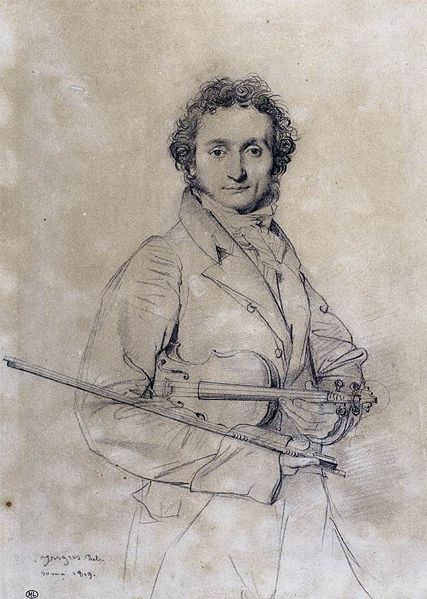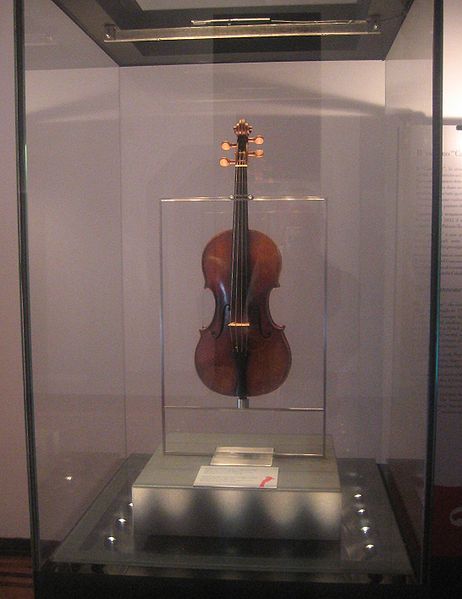<Back to Index>
- Inventor Isaac Merritt Singer, 1811
- Composer Niccolò Paganini, 1782
- 1st Governor of Michigan Stevens Thomson Mason, 1811
PAGE SPONSOR


Niccolò Paganini (27 October 1782 – 27 May 1840) was an Italian violinist, violist, guitarist, and composer. He was one of the most celebrated violin virtuosi of his time, and left his mark as one of the pillars of modern violin technique. His Caprice No. 24 in A minor, Op. 1 is among the best known of his compositions, and has served as an inspiration for many prominent composers.
Niccolò Paganini was born in Genoa, Italy, the third of the six children of Antonio and Teresa (née Bocciardo) Paganini. Paganini's father was an unsuccessful trader, but he managed to supplement his income through playing music on the mandolin. At the age of five, Paganini started learning the mandolin from his father, and moved to the violin by the age of seven. His musical talents were quickly recognized, earning him numerous scholarships for violin lessons. The young Paganini studied under various local violinists, including Giovanni Servetto and Giacomo Costa, but his progress quickly outpaced their abilities. Paganini and his father then traveled to Parma to seek further guidance from Alessandro Rolla. But upon listening to Paganini's playing, Rolla immediately referred him to his own teacher, Ferdinando Paër and, later, Paër's own teacher, Gasparo Ghiretti. Though Paganini did not stay long with Paër or Ghiretti, the two had considerable influence on his composition style.
The
French invaded northern Italy in March 1796, and Genoa was not spared.
The Paganinis sought refuge in their country property in Ramairone. By 1800, Paganini and his father traveled to Livorno,
where Paganini played in concerts and his father resumed his maritime
work. In 1801, Paganini, aged 18 at the time, was appointed first
violin of the Republic of Lucca,
but a substantial portion of his income came from freelancing. His fame
as a violinist was matched only by his reputation as a gambler and
womanizer. In 1805, Lucca was annexed by Napoleonic France, and the region was ceded to Napoleon's sister, Elisa Baciocchi. Paganini became a violinist for the Baciocchi court, while giving private lessons for her husband, Felice. In 1807, Baciocchi became the Grand Duchess of Tuscany and her court was transferred to Florence. Paganini was part of the entourage, but, towards the end of 1809, he left Baciocchi to resume his freelance career. For
the next few years, Paganini returned to touring in the areas
surrounding Parma and Genoa. Though he was very popular with the local
audience, he was still not very well known in Europe. His first break
came from an 1813 concert which took place at La Scala in Milan.
The concert was a great success, and as a result Paganini began to
attract the attention of other prominent, albeit more conservative, musicians across Europe. His early encounters with Charles Philippe Lafont and Ludwig Spohr created intense rivalry. His concert activities, however, were still limited to Italy for the next few years. His fame spread across Europe with a concert tour that started in Vienna in August, 1828, stopping in every major European city in Germany, Poland, and Bohemia until February, 1831 in Strasburg. This was followed by tours in Paris and the United Kingdom of Great Britain and Ireland.
His technical ability and his willingness to display it received much
critical acclaim. In addition to his own compositions, theme and
variations being the most popular, Paganini also performed modified
versions of works (primarily concertos) written by his early
contemporaries, such as Rodolphe Kreutzer and Giovanni Battista Viotti. In
1836, Paganini returned to Paris to set up a casino. Its immediate
failure left him in financial ruins, and he auctioned off his personal
effects, including his musical instruments, to recoup his losses. On
Christmas of 1838, he left Paris for Marseilles and, after a brief
stay, traveled to Nice where he fell ill once more. Paganini, wrongly
assuming it to be a premature gesture, refused the Last Rites to
be performed on him by a priest from the local parish. However, on 27
May 1840, Paganini died from internal hemorrhaging before a priest
could be summoned. It was on these grounds, and his widely rumored association with the devil,
that his body was denied a Catholic burial in Genoa. It took four
years, and an appeal to the Pope, before the body was allowed to be
transported to Genoa, but was still not buried. His remains were
finally put to rest in 1876 in a cemetery in Parma. In 1893, the Czech
violinist, František Ondříček,
persuaded Paganini's grandson, Attila, to allow a viewing of the
violinist's body. After the bizarre episode, Paganini's body was
finally reinterred in a new cemetery in Parma in 1896. Though
having no shortage of romantic conquests, Paganini was once seriously
involved with a singer named Antonia Bianchi from Como, whom he met in
Milan in 1813. The two concertized together throughout Italy. They had
a son, Achilles Cyrus Alexander, born on 23 July 1825, in Palermo and
baptized at San Bartolomeo's. Their union was never legalized and it
ended around April 1828 in Vienna.
Paganini brought Achilles on his European tours, and Achilles would
later accompany his father until the latter's death. He was
instrumental in dealing with his father's burial, years after his death. Throughout his career, Paganini also became close friends with composers Gioachino Rossini and Hector Berlioz. Rossini and Paganini met in Bologna in the summer of 1818. In January 1821, on his return from Naples, Paganini met Rossini again in Rome, just in time to become the composer's substitute conductor for his opera Mathilde de Sharbran,
upon the sudden death of the original conductor. The violinist's
efforts earned gratitude from the composer. Meanwhile, Paganini was
introduced to Berlioz in Paris in 1833. Though Paganini also
commissioned from him Harold en Italie for viola and orchestra, he never performed it, and instead it was premiered a year later by violist Christian Urhan. Despite his alleged lack of interest in Harold, Paganini often referred to Berlioz as the resurrection of Beethoven and, towards the end of his life, he gave large sums to the composer. Paganini
was in possession of a number of fine string instruments. More
legendary than these were the circumstances under which he obtained
(and lost) some of them. While Paganini was still a teenager in Livorno, a wealthy businessman named Livron lent him a violin, made by the master luthier Guarneri,
for a concert. Livron was so impressed with Paganini's playing that he
refused to take it back. This particular violin would come to be known
as Il Cannone Guarnerius. On
a later occasion in Parma, he won another valuable violin (also by
Guarneri) after a difficult sight-reading challenge brought on by a man
named Pasini. Other instruments associated with Paganini include the Antonio Amati 1600, the Nicolò Amati 1657, the Paganini-Desaint 1680 Stradivari, the Guarneri-filius Andrea 1706, the Le Brun 1712 Stradivari, the Vuillaume c.1720 Bergonzi, the Hubay 1726 Stradivari, and the Comte Cozio di Salabue 1727 violins; the Countess of Flanders 1582 da Salò-di Bertolotti, and the Mendelssohn 1731 Stradivari violas; the Piatti 1700 Goffriller, the Stanlein 1707 Stradivari, and the Ladenburg 1736 Stradivari cellos; and the Grobert of Mirecourt 1820 (guitar).
In
September 1834, Paganini put an end to his concert career and returned
to Genoa. Contrary to popular beliefs (involving him wishing to keep
his music and techniques secret), Paganini devoted his time to the
publication of his compositions and violin methods. He accepted
students, of whom two enjoyed moderate success: violinist Camillo
Sivori and cellist Gaetano Ciandelli. Neither considered Paganini
helpful or inspirational, however. In 1835, Paganini returned to Parma,
this time under the employ of Archduchess Marie Louise of Austria, Napoleon's
second wife. He was in charge of reorganizing her court orchestra.
Unfortunately, he eventually became at odds with the players and court,
so his visions never saw the light of day.